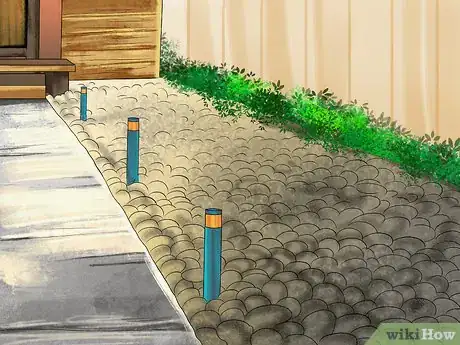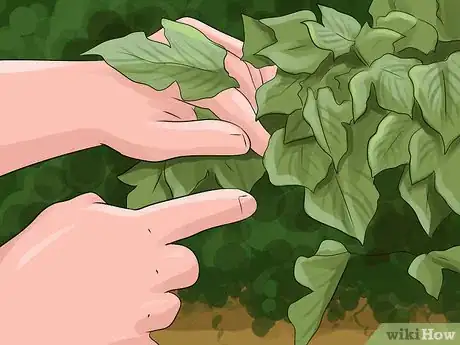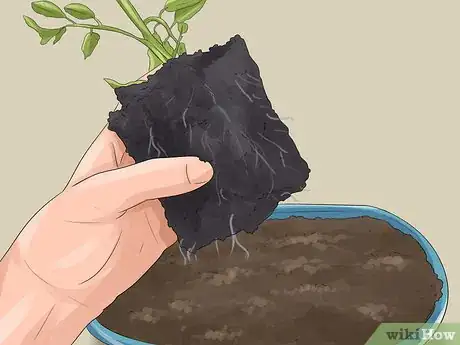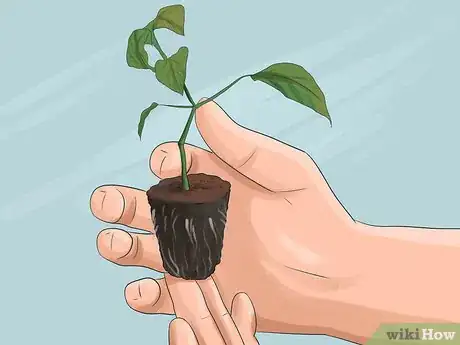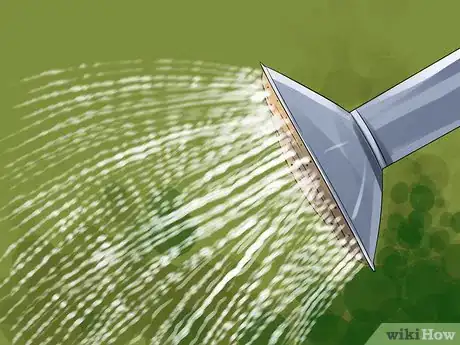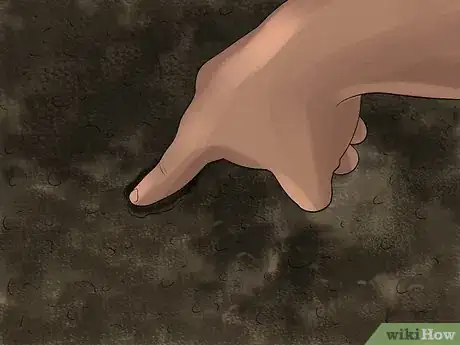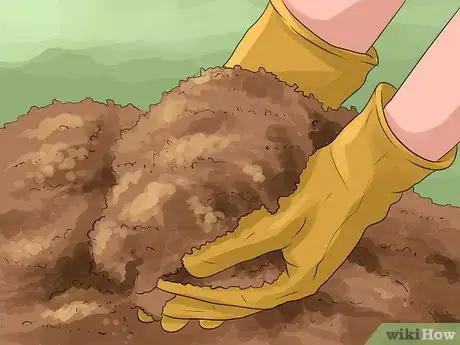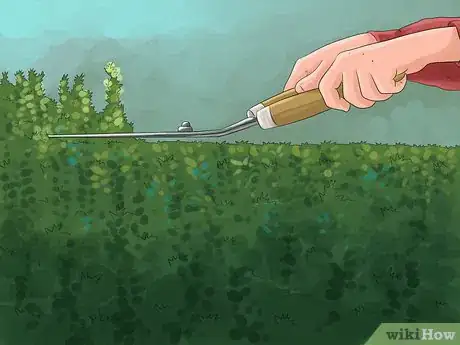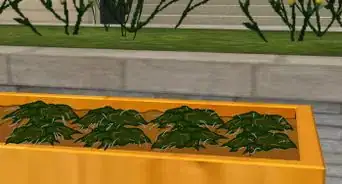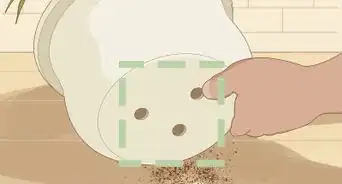This article was co-authored by Lauren Kurtz. Lauren Kurtz is a Naturalist and Horticultural Specialist. Lauren has worked for Aurora, Colorado managing the Water-Wise Garden at Aurora Municipal Center for the Water Conservation Department. She earned a BA in Environmental and Sustainability Studies from Western Michigan University in 2014.
There are 13 references cited in this article, which can be found at the bottom of the page.
wikiHow marks an article as reader-approved once it receives enough positive feedback. In this case, 93% of readers who voted found the article helpful, earning it our reader-approved status.
This article has been viewed 124,912 times.
English ivy is a hardy vine that grows rapidly in warm climates. Although English ivy is actually considered an invasive species in some regions, it is a popular choice for ground cover, or to grow up a wall, trellis, or other structure. English ivy can be grown in the ground or in containers, indoors or outdoors, and can survive in shade, partial shade, or full sun. Due to the extreme hardiness of English ivy, even gardeners with little experience can learn to grow it with success.
Steps
Choosing a Location for Your English Ivy
-
1Determine your hardiness zone. Hardiness zones are categories (based on temperature and location) that determine which plants while grow well in which areas. English ivy is unlikely to thrive outside of hardiness zones 4 to 9. You can determine your hardiness zone by looking in a farmer’s almanac or visiting the USDA website.[1]
-
2Locate an area with fertile and well-drained soil. English ivy likes fertile and well-drained soil. Be sure that the area where you intend to place the plant can accommodate this, or consider using a container (where you can control the planting medium).[2]Advertisement
-
3Select an area that needs “ground cover.” English ivy is notorious for its ability to spread quickly. Check its status in your area before planting.[3]
-
4Look for a wall. Alternatively, you may want your English ivy to climb up a wall, tree, trellis, or other structure. If you live in a brick house, you may even want the ivy to grow and spread over your home. Select a location like this, and plan to plant your ivy nearby.[4]
-
5Locate a container. English ivy can spread so quickly that in some places it is considered an invasive species. As such, you may want to start your English ivy in a container. Any planting container with a drainage hole will work fine. Fill this container with planting medium.[5]
Starting a New English Ivy Plant
-
1Take cuttings from an existing ivy plant in springtime. If you know someone who has an English ivy plant (or if you already have one), begin by taking several 4–5 inches (10–13 cm) clippings. Using a sharp knife (or garden pruners), snip the vines just below a node (the small bump where a leaf grows).[6]
-
2Place the cuttings in a glass of water. Place the water in the sun, and leave the budding plant along until you see white root hairs growing out.[7]
- Rooting the cuttings in water gives you the advantage of seeing how large the roots grow, but it is more difficult to transfer the cuttings to soil once they are large enough.[8]
-
3Place the cuttings in soil. Make sure our to is well draining and filled with moist soil. Avoid putting your English ivy in direct sunlight, and what 3-6 weeks for your ivy to finally start rooting.[9]
-
4
Transplanting the Ivy Outdoors
-
1Moisten your soil. Using a water bottle, spray down your soil (or planting medium) until it is evenly moistened, but not very wet. Make sure your soil drains well.[12]
-
2Find a suitable location. English ivy should not be planted in full sunlight but instead does better in mild shade or indirect sunlight.[13]
-
3Poke holes in the ground that are about 1 to 2 feet (0.30 to 0.61 m) apart. If you are planting your English ivy as a climbing vine, poke holes that are about 2 feet (0.61 m) away from the wall you want your ivy to grow onto.[14]
-
4Water and mulch. English ivy needs to be mulched and watered regularly for optimal growth. Keep the soil evenly moist but not soggy from spring through fall, and then keep it slightly dryer during the winter months.[15]
Maintaining the Ivy
-
1Water the ivy regularly. English ivy needs about 1 inch (2.5 cm) of water every week after the initial planting. This can come from rain or from manual watering. After your ivy is firmly established, you can begin watering less regularly.[16]
-
2Fertilize the ivy plant sparingly. You may choose to give your English ivy a small amount of fertilizer in the spring. You should not use more than 2 tbsp. (30 mL) per square foot (.09 square meters) of slow acting nitrogen fertilizer.[17]
-
3Prune the ivy. You will want to groom your ivy now and then to maintain a clean and tidy appearance. Simply clip stray branches using garden pruners as necessary to keep the shape and appearance of the ivy that you desire.[18]
-
4Cut back well established English ivy beds. Every 3-4 years, you will need to do some more extensive trimming of your established ivy beds. This action will encourage new growth and help your English ivy stay healthy.[19]
-
5Spray with soapy water. If you notice your plant is less vibrant (drooping leaves or loss of color), take a close look for aphids or spider mites. (Although they are tiny, both types of insects are visible with the naked eye.) You can control (or even prevent) these insects by spraying the plant with mild soapy water.[20]
- Combine a few squirts of a mild, chemical-free detergent with filtered water in a spray bottle.
- Gently mist your plant with this soapy water once a day for three days to rid your plant of aphids and spider mites.
- Then, to keep the insects away, spray you plant once every 1-2 weeks, or after a heavy rain.
Community Q&A
-
QuestionCan you grow ivy from cuttings?
 Lauren KurtzLauren Kurtz is a Naturalist and Horticultural Specialist. Lauren has worked for Aurora, Colorado managing the Water-Wise Garden at Aurora Municipal Center for the Water Conservation Department. She earned a BA in Environmental and Sustainability Studies from Western Michigan University in 2014.
Lauren KurtzLauren Kurtz is a Naturalist and Horticultural Specialist. Lauren has worked for Aurora, Colorado managing the Water-Wise Garden at Aurora Municipal Center for the Water Conservation Department. She earned a BA in Environmental and Sustainability Studies from Western Michigan University in 2014.
Professional Gardener Yes, take a 6-inch cutting with new growth and remove 2/3 of the leaves from the cutting. Root as you would other cuttings, in water, soil, or another substrate.
Yes, take a 6-inch cutting with new growth and remove 2/3 of the leaves from the cutting. Root as you would other cuttings, in water, soil, or another substrate. -
QuestionHow often do you water English ivy?
 Lauren KurtzLauren Kurtz is a Naturalist and Horticultural Specialist. Lauren has worked for Aurora, Colorado managing the Water-Wise Garden at Aurora Municipal Center for the Water Conservation Department. She earned a BA in Environmental and Sustainability Studies from Western Michigan University in 2014.
Lauren KurtzLauren Kurtz is a Naturalist and Horticultural Specialist. Lauren has worked for Aurora, Colorado managing the Water-Wise Garden at Aurora Municipal Center for the Water Conservation Department. She earned a BA in Environmental and Sustainability Studies from Western Michigan University in 2014.
Professional Gardener This plant has average water needs but can tolerate some drought. Water it once the soils dries out some.
This plant has average water needs but can tolerate some drought. Water it once the soils dries out some. -
QuestionCan I grow English ivy indoors?
 Lauren KurtzLauren Kurtz is a Naturalist and Horticultural Specialist. Lauren has worked for Aurora, Colorado managing the Water-Wise Garden at Aurora Municipal Center for the Water Conservation Department. She earned a BA in Environmental and Sustainability Studies from Western Michigan University in 2014.
Lauren KurtzLauren Kurtz is a Naturalist and Horticultural Specialist. Lauren has worked for Aurora, Colorado managing the Water-Wise Garden at Aurora Municipal Center for the Water Conservation Department. She earned a BA in Environmental and Sustainability Studies from Western Michigan University in 2014.
Professional Gardener Yes, this plant can be grown indoors. Just be sure to provide the right amounts of sun and water.
Yes, this plant can be grown indoors. Just be sure to provide the right amounts of sun and water.
Warnings
- Be cautious about planting ivy too close to other plants, because it may suffocate them.⧼thumbs_response⧽
- English ivy is very hardy and can quickly take over an area, especially in warm, damp climates. Care should be taken to control the plant and keep it in the desired area. English ivy can be difficult to remove or kill once it is well established.⧼thumbs_response⧽
Things You'll Need
- Fertile soil
- English ivy plant or cutting
- Water
- Fertilizer
- Trimmers
- Mild soap and water
- Rooting hormone
- Trellis, wall, or building for vine climbing
References
- ↑ http://homeguides.sfgate.com/can-english-ivy-plants-full-sunlight-outside-95404.html
- ↑ http://homeguides.sfgate.com/can-english-ivy-plants-full-sunlight-outside-95404.html
- ↑ https://www.doityourself.com/stry/englishivy1
- ↑ http://www.onehundreddollarsamonth.com/dividing-and-transplanting-english-ivy/
- ↑ http://homeguides.sfgate.com/can-english-ivy-grown-cutting-67962.html
- ↑ http://homeguides.sfgate.com/can-english-ivy-grown-cutting-67962.html
- ↑ http://www.epicgardening.com/english-ivy-hedera-helix/
- ↑ http://www.permanentprocrastination.com/2016/01/grow-ivy-from-cutting.html
- ↑ http://www.guide-to-houseplants.com/english-ivy.html
- ↑ http://www.epicgardening.com/english-ivy-hedera-helix/
- ↑ http://www.permanentprocrastination.com/2016/01/grow-ivy-from-cutting.html
- ↑ http://homeguides.sfgate.com/can-english-ivy-grown-cutting-67962.html
- ↑ https://www.chicagobotanic.org/plantinfo/ivy_english
- ↑ https://www.chicagobotanic.org/plantinfo/ivy_english
- ↑ http://www.guide-to-houseplants.com/english-ivy.html
- ↑ http://gardening.yardener.com/Caring-For-English-Ivy
- ↑ http://homeguides.sfgate.com/growing-english-ivy-outdoors-69330.html
- ↑ http://www.gardenguides.com/75533-prune-english-ivy.html
- ↑ http://gardening.yardener.com/Caring-For-English-Ivy
- ↑ http://homeguides.sfgate.com/use-household-dish-soap-control-aphids-40992.html


